No. 19 Squadron RAF
Number 19 Squadron (sometimes written as No. XIX Squadron) was a flying squadron of the Royal Air Force. Formed on 1 September 1915 as a Royal Flying Corps squadron, the unit served during the First World War. No. 19 Squadron was the first squadron in the RAF to operate the Supermarine Spitfire on 4 August 1938, which it flew for the majority of the Second World War. The squadron operated several different types during the Cold War from the Gloster Meteor F.4 to the McDonnell Douglas Phantom FGR.2 as No. 19 (Fighter) Squadron. From September 1992 until November 2011, the unit was designated No. 19 (Reserve) Squadron. The unit most recently operated the BAe Hawk T.1, T.1A and T.2 from RAF Valley until it was disbanded on 24 November 2011.
| No. XIX Squadron RAF | |
|---|---|
.png.webp) | |
| Active | 1 September 1915 – 1 April 1918 (RFC) 1 April 1918 – 31 December 1919 (RAF) 1 April 1923 – 31 December 1976 1 January 1977 – 9 January 1992 23 September 1992 – 24 November 2011 |
| Country | |
| Branch | |
| Motto(s) | Latin:Possunt quia posse videntur (Translation: "They can because they think they can")[1] |
| Battle honours |
|
| Insignia | |
| Squadron Badge heraldry | Between wings elevated and conjoined in base, a dolphin, head downwards.[1][2] |
| Squadron Roundel |  |
| Squadron Codes | WZ (Oct 1938 – Sep 1939)[3][4] QV (Sep 1939 – Sep 1945)[5][6] A (1989 – 1991)[7] |
History
First World War
No. 19 Squadron of the Royal Flying Corps was formed on 1 September 1915, from members of No. 5 Squadron, at Castle Bromwich[8][9] training on a variety of aircraft before being deployed to France in July 1916 flying Royal Aircraft Factory B.E.12 and re-equipping with the more suitable French-built SPAD S.VIIs.
From November 1917, the squadron started to receive Sopwith Dolphins to replace its Spads, it being fully equipped with the Dolphin during January 1918, flying its first operational patrol with the new fighter on 3 February.[10] In 1918, the squadron was re-equipped with Sopwith Dolphins, flying escort duties. By the end of the war, 19 Squadron had had a score of flying aces among its ranks, including Albert Desbrisay Carter, John Leacroft, Arthur Bradfield Fairclough, Oliver Bryson, Gordon Budd Irving, Frederick Sowrey, future Air Commodore Patrick Huskinson, Cecil Gardner, Roger Amedee Del'Haye, future Air Chief Marshal James Hardman, Finlay McQuistan, Alexander Pentland, John Candy, Cecil Thompson, John Aldridge,[11] and Wilfred Ernest Young.[12] Commanding officers during this time included H.D. Harvey-Kelly who was the first RFC pilot to land in France in the First World War. At least one of 19 Sqn. fliers, a Canadian, George Robert Long, was captured on 6 October 1917 in the Lille area and spent the rest of the war in a number of POW camps, including Holzminden POW camp. It was his very first flight, in a Spad VII, B3508. He was shot down by Gefr. J. Funk, flying with Ja30. He had first been a member of the C.E.F. in the infantry and was wounded a number of times. He wasn't repatriated until 14 December 1918, to return home to Ottawa, Ontario, Canada.
Interwar period
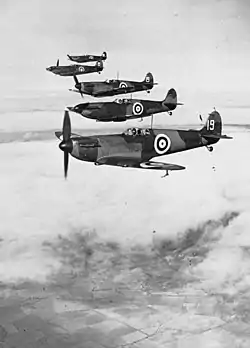
No. 19 Squadron was disbanded after the First World War on 31 December 1919.[13] On 1 April 1923, the squadron was reformed at RAF Duxford with the Sopwith Snipe, initially operating as part of No. 2 Flying Training School (No. 2 FTS).[13][14] After becoming independent No. 2 FTS, No. 19 Squadron remained at Duxford flying number of different fighters such as the Gloster Grebe, Armstrong Whitworth Siskin Mk.IIIa and the Bristol Bulldog Mk.IIa.[9] In May 1935, the unit became the first squadron to be equipped with the Gloster Gauntlet which they flew until March 1939.[15] In 1938, No. 19 Squadron became the first squadron in the RAF to operate the Supermarine Spitfire Mk.I,[16][17] when K9789 was delivered on 4 August.[18] The squadron lost its first Spitfire when K9792 crashed on landing at RAF Duxford on 20 September 1938, having only been delivered on 16 August.[19]
Second World War
No. 19 Squadron was stationed at RAF Duxford after the outbreak of the Second World War in September 1939, and was part of No. 12 Group, RAF Fighter Command.[20] Douglas Bader was posted to the squadron in February 1940.[21] In May and June 1940, the squadron helped provide air cover over the Dunkirk beaches.[14] In June 1940, No. 19 Squadron began the receive Spitfire Mk.Ibs, which were armed with the Hispano cannon, however due to reliability issues the unit soon reverted to the Spitfire Mk.Ia.[9] No. 19 Squadron formed part of the Duxford Wing, No. 12 Group's 'Big Wing' formation during the Battle of Britain.[2]
Later versions of Spitfires were flown until the arrival of North American Mustang Mk.IIIs for close-support duties in early 1944.[22] After D-Day, No. 19 Squadron briefly went across the English Channel before starting long-range escort duties from RAF Peterhead, Scotland, for Coastal Command off the coast of Norway.[23] The Squadron converted to the Mustang Mk.IV in April 1945 while based at RAF Peterhead.[24]
Cold War
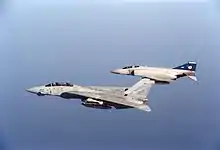
Relocating south to RAF Acklington on 13 May 1945, No. XIX (Fighter) Squadron exchanged their Mustangs for Spitfire Mk.XVIs.[24][25] While at RAF Wittering in October 1946, No. 19 (F) Squadron converted to the de Havilland Hornet Mk.I which were operated until January 1951 when the Squadron received their first jet aircraft – the Gloster Meteor F.4.[26] These were soon exchanged for the Meteor F.8 in April 1951 which were flown until October 1956 when No. 19 (F) Squadron received the Hawker Hunter F.6.[14] The Squadron moved to RAF Leconfield, Yorkshire in 1959 where they converted to the English Electric Lightning F.2 in November 1962.[26]
The Squadron and her sister unit, No. 92 (F) Squadron, were deployed forwards in September 1965 to RAF Gütersloh, close to the inner German border, as part of Second Allied Tactical Air Force (2ATAF).[14] Subsequently, the squadron re-equipped with the longer-range Lightning F.2A version.
On 31 December 1976, No. 19 (F) Squadron disbanded with the Lightning, followed by No. 92 (F) Squadron in March 1977, and reformed the next day at RAF Wildenrath,[22] further back west of the Rhine, with the McDonnell Douglas Phantom FGR.2 still in the air defence role. The Squadron operated for the first time out of newly introduced dispersed and Hardened Aircraft Shelters, including associated Nuclear, Biological and Chemical filtered operations rooms.
Because of restricted airspace in then West Germany, both No 19 Squadron and its sister No 92 Squadron deployed regularly out of theatre over these years for annual Missile Practice Camps at RAF Valley, using the Aberporth Range in Wales, to RAF St Mawgan in Cornwall and RAF Akrotiri in Cyprus for Armament Practice Camps (gunnery), to Italian Air Force Decimommanu in Sardinia to use the NATO Air Combat Manoeuvring Instrumented Range, and latterly to Eglin and Nellis Air Force Bases in Florida and Nevada to participate respectively in multi national Exercises Green and Red Flags.
On 17 August 1990, No. XIX (F) Squadron, along with No. 92 (F) Squadron, were sent to RAF Akrotiri, Cyprus, in order to provide air defence for the island after Tornado F.3s from No. V (AC) Squadron and No. 29 (F) Squadron deployed from Akrotiri to Dhahran Airfield due to the Iraqi Invasion of Kuwait (ahead of Operation Granby).[27] No. 19 (F) Squadron operated their Phantoms from here until 28 February 1991 when a ceasefire was called between the coalition forces and Iraq.[14]
On 9 January 1992, the squadron disbanded as part of agreed post-Cold War force reductions and their aircraft were scrapped.[26][28]
Hawk (1992–2011)
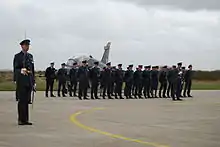
The number plate was then assigned to the former No. 63 Squadron, one of the Hawk squadrons at RAF Chivenor, in September 1992, becoming No. 19 (Reserve) Squadron. The squadron was a 'Shadow' identity of No. 2 Tactical Weapons Unit (2 TWU). Following the closure of Chivenor to jet flying the squadron was moved to RAF Valley in September 1994 to provide advanced fast jet training on the BAE Hawk.
In May 2008, Hawk T.1 XX184 was re-painted in a special Spitfire camouflage livery at RAF Valley. This was done to celebrate the 70th anniversary of the squadron as the first operational fighter squadron to fly the Supermarine Spitfire from Duxford in 1938.
As a consequence of the UK's Strategic Defence and Security Review in 2010, the Air Force Board decided in 2011 that 19 Squadron's training role with the Hawk T2 at RAF Valley should be transferred to a resurrected No. 4(R) Squadron. No. 19(R) Squadron, one of the last surviving Battle of Britain squadrons, disbanded on 24 November 2011, 96 years after it was first formed.[29]
The disbandment event, held at RAF Valley, was led by the Wg Cdr Kevin Marsh, the last Commanding Officer of 19 Squadron. In attendance were the Chief of Air Staff, Air Chief Marshal Sir Stephen Dalton KCB ADC BSc FRAeS CCMI RAF, former Air Chief Marshal Sir William Wratten, GBE, CB, AFC and Flt Lt Ken Wilkinson AE who flew Spitfires in the Battle of Britain on 19 Squadron.
Aircraft operated
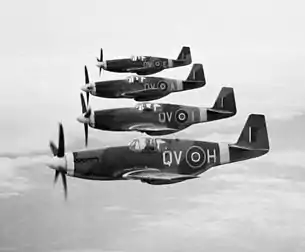
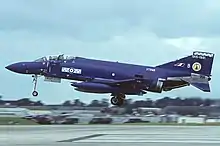
| From | To | Aircraft | Version |
|---|---|---|---|
| September 1915 | October 1915 | Farman MF.11 Shorthorn | |
| September 1915 | October 1915 | Avro 504 | |
| September 1915 | October 1915 | Caudron G.3 | |
| October 1915 | December 1915 | Royal Aircraft Factory B.E.2 | c |
| December 1915 | December 1915 | Royal Aircraft Factory R.E.7 | |
| February 1916 | July 1916 | Avro 504 | |
| February 1916 | July 1916 | Caudron G.3 | |
| February 1916 | July 1916 | Bristol Scout | |
| February 1916 | July 1916 | Martinsyde S.1 | |
| February 1916 | July 1916 | Royal Aircraft Factory B.E.2 | c |
| February 1916 | July 1916 | Royal Aircraft Factory F.E.2 | b |
| February 1916 | July 1916 | Royal Aircraft Factory R.E.5 | |
| February 1916 | July 1916 | Royal Aircraft Factory R.E.7 | |
| June 1916 | February 1917 | Royal Aircraft Factory B.E.12 | |
| October 1916 | January 1918 | SPAD S.VII | |
| June 1917 | January 1918 | SPAD S.XIII | |
| November 1917 | February 1919 | Sopwith Dolphin | |
| April 1923 | December 1924 | Sopwith Snipe | |
| December 1924 | April 1928 | Gloster Grebe | |
| March 1928 | September 1931 | Armstrong Whitworth Siskin | Mk.IIIa |
| September 1931 | January 1935 | Bristol Bulldog | Mk.IIa |
| January 1935 | March 1939 | Gloster Gauntlet | Mk.I |
| September 1936 | February 1939 | Gloster Gauntlet | Mk.II |
| August 1938 | December 1940 | Supermarine Spitfire | Mk.I |
| June 1940 | September 1940 | Supermarine Spitfire | Mk.Ib |
| September 1940 | November 1941 | Supermarine Spitfire | Mk.IIa |
| October 1941 | August 1943 | Supermarine Spitfire | Mk.Vb |
| September 1942 | March 1943 | Supermarine Spitfire | Mk.Vc |
| August 1943 | January 1944 | Supermarine Spitfire | Mk.IX |
| January 1944 | April 1945 | North American Mustang | Mk.III (P-51 B/C) |
| April 1945 | March 1946 | North American Mustang | Mk.IV (P-51D) |
| March 1946 | November 1946 | Supermarine Spitfire | LF.16e |
| October 1946 | May 1948 | de Havilland Hornet | F.1 |
| March 1948 | January 1951 | de Havilland Hornet | F.3 |
| January 1951 | June 1951 | Gloster Meteor | F.4 |
| April 1951 | January 1957 | Gloster Meteor | F.8 |
| October 1956 | February 1963 | Hawker Hunter | F.6 |
| November 1962 | October 1969 | English Electric Lightning | F.2 |
| January 1968 | December 1976 | English Electric Lightning | F.2a |
| January 1977 | January 1992 | McDonnell Douglas F-4M Phantom | FGR.2 |
| September 1992 | November 2011 | BAe Hawk | T.1 / T.2 |
References
- Notes
- Palmer 1991, p. 3.
- "19 Squadron". Royal Air Force. 2015. Archived from the original on 3 March 2016. Retrieved 19 October 2015.
- Bowyer and Rawlings 1979, p. 11.
- Flintham and Thomas 2003, p. 52.
- Bowyer and Rawlings 1979, p. 87.
- Flintham and Thomas 2003, p. 99.
- Flintham and Thomas 2003, p. 229.
- Halley 1988, p. 55.
- "No 19 Squadron". Air of Authority - A History of RAF Organisation. Retrieved 23 April 2020.
- Chorlton Aeroplane Autumn 2014, p. 58.
- "19 Squadron". The Aerodrome. 2015. Retrieved 19 October 2015.
- "Wilfred Ernest Young". The Aerodrome. 2015. Retrieved 19 October 2015.
- Rawlings 1978, p. 47.
- "No.19 Squadron". Royal Air Force Museum. Retrieved 28 March 2019.
- "No 19 Squadron Aircraft & Markings 1916 - 1931". Air of Authority - A History of RAF Organisation. Retrieved 23 April 2020.
- Rawlings 1978, p. 48.
- "British Military Aviation in 1938". Royal Air Force Museum. Archived from the original on 14 May 2012. Retrieved 23 April 2020.
- "Supermarine Spitfire". Tangmere Museum. Retrieved 23 April 2020.
- "Incident Supermarine Spitfire Mk I K9792, 20 Sep 1938". Aviation Safety Network. Retrieved 23 April 2020.
- Rawlings 1978, p. 525.
- "Douglas Bader - A fighter pilot again". Royal Air Force Museum. Retrieved 23 April 2020.
- Halley 1988, p. 56.
- Rawlings 1978, p. 49.
- "No. 19 Squadron (RAF): Second World War". History of War. Retrieved 28 March 2019.
- "No 19 Squadron Aircraft & Markings 1931 - 1946". Air of Authority - A History of RAF Organisation. Retrieved 28 March 2019.
- "No 19 Squadron". Air of Authority - A History of RAF Organisation. Retrieved 28 March 2019.
- "THE HISTORY OF RAF AKROTIRI 1955 - 2005". RAF Akrotiri. Retrieved 28 March 2019.
- "19 Squadron". Royal Air Force. Archived from the original on 25 April 2017. Retrieved 28 March 2019.
- "IV Squadron Reborn". Royal Air Force. 24 November 2011. Retrieved 19 October 2015.
- Jefford 2001, pp. 33-34.
- Palmer 1991, pp. 353-374.
- Bibliography
- Bowyer, Michael J.F. and John D.R. Rawlings. Squadron Codes, 1937-56. Bar Hill, Cambridgeshire, UK: Patrick Stephens Ltd., 1979. ISBN 0-85059-364-6.
- Chorlton, Martyn. "The Determined Dolphins". Aeroplane, Autumn 2014, Vol. 42, No. 9. pp. 58–62. ISSN 0143-7240.
- Delve, Ken. The Source Book of the RAF. Shrewsbury, Shropshire, UK: Airlife Publishing, 1994. ISBN 1-85310-451-5.
- Flintham, Vic and Andrew Thomas. Combat Codes: A Full Explanation and Listing of British, Commonwealth and Allied Air Force Unit Codes since 1938. Shrewsbury, Shropshire, UK: Airlife Publishing Ltd., 2003. ISBN 1-84037-281-8.
- Halley, James J. The Squadrons of the Royal Air Force & Commonwealth, 1918-1988. Tonbridge, Kent, UK: Air-Britain (Historians) Ltd., 1988. ISBN 0-85130-164-9.
- Jefford, C.G. RAF Squadrons, a Comprehensive Record of the Movement and Equipment of all RAF Squadrons and their Antecedents since 1912. Shrewsbury, Shropshire, UK: Airlife Publishing, 1988 (second edition 2001). ISBN 1-85310-053-6.
- Palmer, Derek. Fighter Squadron (No. 19). Upton-upon-Severn, Worcestershire, UK: Self Publishing Association, 1991. ISBN 1-85421-075-0.
- Palmer, Derek. 19 Fighter Squadron, RAF. Published by Derek Palmer, 2008. ISBN 978-0-9558970-0-9.
- Rawlings, John D.R. Fighter Squadrons of the Royal Air Force and their Aircraft. London: MacDonald and Jane's (Publishers) Ltd., 1969 (new edition 1976, reprinted 1978). ISBN 0-354-01028-X. pp. 47–54.
External links
| Wikimedia Commons has media related to No. 19 Squadron RAF. |
